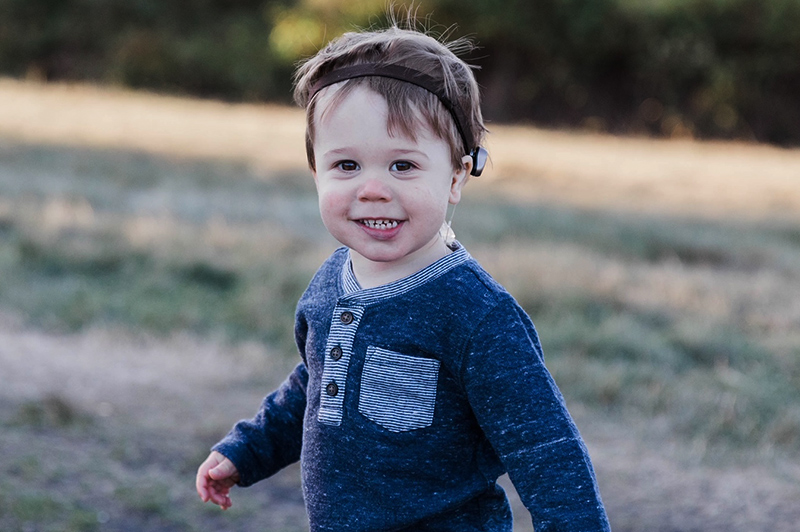What are bone-anchored hearing systems?
Bone-anchored hearing systems (BAHS) are a category of devices used to treat some ear conditions that interfere with hearing.
BAHS devices give patients access to speech and language by bypassing impairments of the external ear (the visible part of the ear) or middle ear and sending sound vibrations directly to the inner ear. BAHS devices are commonly placed on the head near the ear. They can be held in place with a softband or a surgically implanted abutment or magnet.
Who can benefit from a bone-anchored hearing system?
Children and adults with permanent bilateral, unilateral conductive, or mixed hearing loss can benefit from a BAHS. People with single-sided deafness can also benefit.
Conditions that may be treated with a BAHS include:
- microtia with external ear canal atresia
- hemifacial microsomia
- Treacher Collins syndrome
- Nager syndrome
- cholesteatoma
- chronic middle ear dysfunction with persistent drainage

Owen's bone-anchored hearing story
With the help of his bone-anchored hearing system, Owen is fluent in both spoken English and American Sign Language.
What are the different types of bone-anchored hearing systems?
BAHS have processors with microphones that pick up sound and send it directly to the inner ear through bone vibration. There are several different BAHS options:
- Softband: A BAHS processor is attached to a softband (headband). The softband is worn around your child’s head throughout the day and removed at night.
- Percutaneous: A BAHS processor abutment is surgically placed under the skin on your child’s head. The surgical procedure often occurs in two stages.
- Transcutaneous: The BAHS processor system has both an internal and external component. The surgical procedure is often completed in a single stage.
Is my child old enough for a bone-anchored hearing system?
Children as young as 6 months old can be fitted for a BAHS softband, which doesn’t require surgery.
Your child must be at least 5 years old to qualify for a surgically implanted BAHS.
How will I know if my child is qualified for a BAHS device?
Your child will need to have an up-to-date hearing evaluation to determine if they are a candidate for a BAHS. Before surgery is scheduled, your child will also meet with a psychologist in the Deaf and Hard of Hearing Program.
What to expect during your child’s BAHS evaluation
Your child will undergo a series of tests, including a diagnostic hearing assessment, to determine if a BAHS could effectively improve their access to speech and sounds.
- An audiologist will ask about your child’s medical and hearing history, including the results of previous hearing tests. They’ll also discuss the results of your child’s hearing test and candidacy for a device with you.
- A BAHS otolaryngologist will conduct a medical evaluation of your child’s hearing loss.
- A speech-language pathologist will evaluate your child’s speech and language.
If the test results indicate that your child could benefit from bone-anchored hearing, you will meet with a BAHS audiologist for a demonstration, counseling, and recommendations.
What to expect when choosing a BAHS softband device
If you decide to try a BAHS softband device, your child will be fit with a processor and wear it for at least two weeks. Your child’s audiologist will help you determine if the device was beneficial to help you decide if you want to move forward with this option for your child.
What to expect after BAHS surgery
If your child has a BAHS surgically implanted, they will meet with their otolaryngologist and audiologist after surgery. The audiologist will program the device and show you and your child how to use and care for the processor. About every six months, your child will have a hearing test followed by programming and adjustments to their BAHS device.
Bone-Anchored Hearing Systems | Programs & Services
Programs
Bone-Anchored Hearing System Program
Program
The Bone-Anchored Hearing System Program provides solutions for patients for which a traditional hearing aid is ineffective.
Speech-Language Pathology Program
Program
The Speech-Language Pathology Program provides services for children of all ages who experience difficulties with speech sound production, resonance, voice, fluency, language, and feeding and swallowing.
Microtia Program
Program
The Microtia Program treats microtia, a relatively rare birth defect that leads to ear anomalies and possible hearing loss.
Deaf and Hard of Hearing Program
Program
The Deaf and Hard of Hearing Program provides comprehensive evaluation and consultative services to D/deaf and hard of hearing children.
Down Syndrome Program
Program
The Down Syndrome Program offers specialized services for children with Down syndrome and their families.
Cleft Lip and Palate Program
Program
The Cleft Lip and Palate Program is one of the largest and most experienced treatment centers in the country.
Cochlear Implant Program
Program
The Cochlear Implant Program is the largest and most comprehensive pediatric cochlear implant program in New England.
Craniofacial Program
Program
Our program has a skilled team of clinicians experienced in diagnosing and treating children with a wide variety of craniofacial conditions.
Departments
Otolaryngology and Communication Enhancement
Department
The Department of Otolaryngology and Communication Enhancement provides care for a wide variety of congenital and acquired conditions of the head and neck, ranging from airway obstruction and thyroglossal duct cysts to chronic ear and sinus infections.
Learn more about Otolaryngology and Communication Enhancement
Plastic and Oral Surgery
Department
The Department of Plastic and Oral Surgery is one of the largest and most experienced pediatric plastic and oral surgery centers in the world, with 10 dedicated subspecialty programs.

